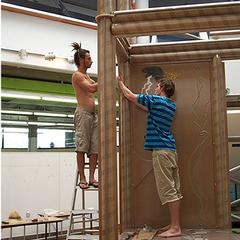Winning Proposal
Introduction
A ragged busker is taking refuge in an anonymous vestibule, he begins singing 'no women no cry', a comrade joins him merrily grating a tree branch to a ribbed plastic tube in time to the worn but melodious guitar. Gradually passers by are drawn into the space by the energy of the impromptu performance. Suddenly, this ordinarily neglected space is transformed by the creative initiative of two young men trying to scrape together enough for a meal ticket and a place to sleep. In the process an unowned space of no distinct character becomes temporary stage, dance floor and amphitheatre.
Although my time in Barcelona was short, I was captured by this lively city and the dramatic adaptation of leftover space by its people. Whether it is the temporary market stalls that appear and disappear without ever seeing daylight, dynamic political messages painted on walls, street performers in the piazza's or squatters inhabiting disused buildings, people are creatively altering space to accommodate their needs.
Barcelona is a city where the flamboyancy of its people and the vibrancy of its urban fabric are renowned across the world. Not surprisingly land in Barcelona is some of the most highly contested in Spain, real-estate continues to increase in price and decrease in attainability. In the year of 1999, the price of land increased by 22% while the number of vacant properties was estimated at 13.7% and still continues to grow . As in Sydney, youth find it increasingly difficult to secure affordable accommodation within metropolitan Barcelona.
With constraints come innovations, as previous explorations within Philippine waste picker communities and Sydney's squatted warehouses have demonstrated. Barcelona's poor have been bypassing formal housing bodies, in place of a self-help model consisting of an extensive network of Social Centres, housing cooperatives and communes; around 30 squatted Social Centres exist in the City of 3 million . These politically, environmentally and socially responsive centres have developed an important role in Catalan society; "not just a living house but also a [community] meeting point for social and political events…parties, political discussions, silk screen-printing".
While this informal and creative approach to housing is not without problems, such as lack of personal and tenure security, overcrowding and privacy, these centres in the context of Barcelona's dynamic social fabric and innovative sustainable living practices, provide an invaluable opportunity to continue my explorations into self-help housing; particularly the implications of this approach to the provision of affordable and sustainable housing, inclusive city development and the relevance of the architectural profession to a greater humanity.
Aim
1.To explore issues facing Barcelona's displaced youth and the nature of self-help architectural solutions developed, looking specifically at: -the use of borrowed/recycled space and materials and their role in housing the displaced.
-the integration, interaction and role of these social housing alternatives within the surrounding urban fabric.
2.To investigate alternative materials and technologies for sustainable building, servicing of buildings and clean energy sources that are both user friendly and cost-effective.
3.To analyse the implications of the above findings to the provision of affordable housing and inclusive city development in Barcelona and in Sydney. Explore implications of the self-help approach to the practice of architecture and its relevance to a greater humanity.
Methodology
The Forums:
Attend Forum Barcelona 2004 to gain an understanding of core themes: Cultural Diversity, Sustainable Development and Conditions for Peace. Attend Arquitectura 3000 to gain understanding of core themes: Mind, Land and Social.
Attend lectures, workshops and exhibits of relevance to: -cultural diversity and understanding, global homelessness and grassroots/self-help housing movements.
-sustainable technologies and practices, particularly exploring their application to self-help architecture. Examine the infrastructure of the Forum and sustainable practices utilised within the operations of the event and on adjacent lands dubbed the "City Metabolism". Particularly examine: energy generation and conservation, waste reduction/recycling, renewable material utilisation and the nearby photovoltaic module.
The City:
Investigate physical, social and cultural aspects of social centres, communes and co-operatives potentially including but not limited to:
-Okupat Torreblanca St.Cugat: urban social centre.
-Can Pasqual Les Planes de Vallvidrera: self-sufficient commune.
-Tekno Circus Barcelona: informal power-plant adaptation to community use.
-Cine Princesa + Gazpacho: prominent evicted urban squats.
Observe public spaces that people have informally personalised to alter use and character; whether temporary or permanent.
Documentation:
Document Forum and City investigations in the form of sketches notes and photograph's (where permitted). Undertake informal interviews where appropriate.
Programme:
Week one: Initial explorations: walk around city, inhabit various public squares, meet contacts from case studies and attend relevant Forum events.
Week Two: In-depth explorations: explore case studies in-depth and analyse Forum and City sustainable practices, attend relevant Forum events.
|
|

